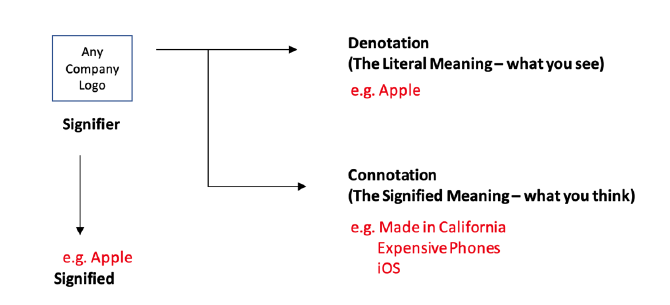

Rakesh Gandla & Lalith Kumar Vemali
C0002
March 2023
In the world of branding, using symbols and signs effectively is essential to developing a powerful and recognisable identity. Semiotics, the study of signs, symbols, and how they are interpreted, is important in forming brand perception and affecting consumer behaviour. Being able to convey a company's message and values through visual signals is crucial to building a strong and successful brand. In order to better understand how signs and symbols are used to influence customer behaviour, this article will investigate the connection between semiotics and brand perception. We will examine the fundamentals of semiotics, how it affects consumer behaviour and brand perception, the value of brand identity, and the best methods for integrating semiotics into branding.
We will also look at recent developments in semiotic branding and how technology is influencing this important aspect of effective branding in the future. With this investigation, we hope to offer tips and advice to help businesses develop a distinctive brand identity that appeals to their target market and encourages customer loyalty.
Semiotics is the study of signs and symbols, as well as their interpretation, communication, and meaning-making. Understanding how people interpret and produce meaning from diverse types of communication, including as language, visual signs, gestures, and symbols, is required. Semiotics investigates the underlying messages and cultural values expressed by these signs and symbols, as well as how they impact our view of the world around us. Semiotics is the study of how visual and symbolic components such as logos, packaging, and advertising transmit a brand's message and values to its audience in the context of branding.
Semiotics is important in branding because it helps businesses create a strong and recognisable brand identity that resonates with their target audience. The use of symbols and signs is a powerful way to communicate a brand's message and values while also differentiating it from competitors. Semiotics assists businesses in developing effective branding strategies by providing insights into how their target audience interprets and creates meaning from visual and symbolic elements.
Businesses may develop stronger branding strategies that encourage customer involvement and loyalty by comprehending how semiotics affects consumer behaviour and brand perception. With the use of semiotics, businesses may convey their message in a way that connects with their target market and leaves a lasting impact. Semiotics is therefore a crucial element of effective branding in the cutthroat economy of today.
Given that they serve as the fundamental building blocks of communication and the construction of meaning, signs and symbols play a significant role in semiotics. To express specific meanings and messages to the observer or listener, signs and symbols can take many different forms, including visual pictures, phrases, sounds, and gestures. Signs and symbols are employed in branding to establish a distinctive and enduring brand identity that appeals to the target market.
Signs and symbols are especially effective in developing a visual language that communicates a brand's message and values. Through its design, colour, and shape, a logo, for example, can convey a brand's identity and values. Similarly, packaging design can employ signs and symbols to communicate product information such as ingredients, benefits, and usage instructions.
Signs and symbols, in short, play an important role in semiotics and branding because they assist businesses in developing a strong and recognisable brand identity that communicates their message and values to their target audience.
Icon: An icon is a sign or symbol that physically resembles or represents the thing to which it refers. A picture of a hamburger, for example, is an icon that represents the food item.
Index: An index is a sign or symbol that has a direct or causal relationship to the thing to which it refers. For example, smoke is a fire indicator.
Symbol: A symbol is a sign or symbol that has a cultural or traditional association with the thing to which it refers. A heart, for example, is a symbol of love.
Metaphor: A metaphor is a sign or symbol that is used to describe something in terms of something else. Calling someone a "night owl," for example, is a metaphor that describes their behaviour as similar to that of an owl.
Simile: A simile is a sign or symbol that compares one thing to another by using the words "like" or "as". "The wind was howling like a wolf," for example, is a simile.
Indexical: An indexical sign is a sign or symbol that refers to a particular context or situation. A traffic sign that warns of a curve ahead, for example, is an indexical sign that is specific to that location.

Signs and symbols are important in shaping brand perception because they are frequently the first point of contact between a brand and its target audience. A logo's design, colour, and style, as well as packaging and advertising campaigns, are all important factors in how a brand is perceived. The use of signs and symbols can establish a strong emotional bond between a brand and its audience, evoking positive feelings and associations that contribute to a favourable brand perception. A logo with bold, bright colours, for example, can convey excitement and energy, whereas a more subtle and sophisticated design can convey elegance and refinement.
At the same time, signs and symbols can convey negative associations, which can have a negative impact on brand perception. A poorly designed logo, for example, or unappealing packaging, for example, can create a negative first impression, leading consumers to associate the brand with low quality or unprofessionalism. Semiotics is crucial in understanding how signs and symbols influence brand perception. Businesses can gain insights into how their target audience perceives their brand by carefully analysing the design and style of branding elements, and then make strategic decisions about how to improve their brand image.
In conclusion, signs and symbols are powerful tools that can shape both positive and negative brand perception. Businesses can create effective branding strategies that drive positive brand perception and long-term success by using semiotics to understand how their target audience interprets and responds to these elements.
Creating Associations: Companies can create associations with certain values or attributes by using symbols, signs, and other visual elements in their branding. A luxury brand, for example, may use gold or silver colours, which are frequently associated with wealth and exclusivity, to create the perception of a high-end product. Based on these associations, consumers may be more likely to purchase the product.
Emotion Elicitation: Semiotics can be used to elicit emotional responses from customers. A brand, for example, may use warm colours or playful imagery to convey a sense of joy or excitement, whereas darker colours or more serious imagery may convey a sense of sophistication or gravitas. These feelings can contribute to positive brand associations and increase the likelihood of purchase.
Information Communication: Symbols and signs can also be used to convey information about a product or brand. For example, the "recycling" symbol communicates that a product is environmentally friendly, whereas a heart-shaped logo may indicate that a brand is concerned with health and wellness. Semiotics can help to communicate this information quickly and effectively to consumers, who are more likely to purchase products that align with their values or needs.
Finally, semiotics can aid in the development of brand recognition and familiarity over time. Companies can create a sense of familiarity with their customers by consistently using the same symbols, colours, and other visual elements in their branding. As consumers associate these visual elements with the quality and dependability of the brand, this can help to build trust and loyalty. This recognition can help to drive repeat business and increase customer lifetime value over time.
Differentiating a brand from its competitors: Semiotics can also be used to distinguish a brand from its competitors. A brand can stand out in a crowded marketplace by using distinctive symbols, colours, and other visual elements. This is especially important in industries with many similar products or brands, as semiotics can assist a brand in establishing a unique selling proposition and making an impression on consumers.
Building Trust: Semiotics can also be used to increase consumer trust. A brand can signal to consumers that it is trustworthy and worth doing business with by using symbols and signs associated with positive attributes such as quality, reliability, and safety. Semiotics can help establish credibility and overcome scepticism, which is especially important for new or unknown brands.
Creating a Sense of Belonging: Semiotics can also be used to help consumers feel a sense of belonging. A brand can create a sense of identity and connection with its target audience by using symbols and signs associated with specific communities or subcultures. Semiotics can help brands create a sense of authenticity and relevance, which can be especially effective for brands targeting younger consumers or those in niche markets.
Personalization: As big data and artificial intelligence become more prevalent, brands are increasingly able to tailor their messaging and visual identity to individual consumers. Data is used to understand individual preferences, and branding elements are tailored to create a more personalised and targeted experience for each consumer.
Social Media Storytelling: Brands are increasingly using visual elements to create engaging and shareable content that resonates with their target audience on social media. Semiotic elements such as emojis, GIFs, and memes are increasingly being used by brands to create engaging and memorable content that drives engagement and loyalty.
Sustainability & Eco-friendly: Consumers are increasingly concerned about sustainability and environmental friendliness, and brands are responding by incorporating semiotic elements that communicate their commitment to these values. Using natural colours, ecofriendly packaging, and symbols that communicate environmental sustainability are all examples of this.
Globalization: As brands enter new markets, they must consider the local market's semiotic codes and cultural context to ensure that their branding strategy resonates with local consumers. This entails adapting semiotic elements to the local market's cultural context and preferences.
Augmented reality (AR): With the rise of AR technology, brands are experimenting with new ways to use semiotics to create immersive and interactive brand experiences. This can include using augmented reality to create virtual brand experiences that include semiotic elements like logos, colours, and other visual elements.
Future branding strategies will need to be highly adaptable in order to incorporate new trends and technologies as they emerge while maintaining a strong focus on the semiotic elements that drive brand perception and consumer behaviour. Brands can create a strong and effective brand identity that resonates with consumers across multiple touchpoints and platforms by staying up to date with emerging trends and incorporating them into their branding strategy.